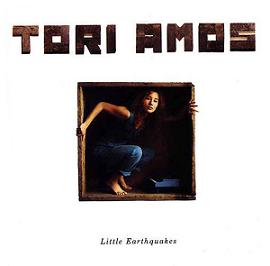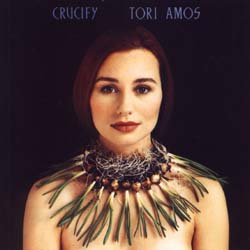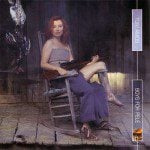(Pagans don’t proselytize, and the majority of us don’t have Pagan parents; as a result, people come to Modern Paganism through various means. For many of us, books, movies, and music provided the impetus to walk the Pagan Path. Gateways to Paganism is one guy’s attempt to document some of the things that have led various people to Paganism, and why those things had that effect.)
There was a time in the early to mid-90’s when I was obsessed with Tori Amos. For a generation of Pagans, Tori Amos was our artist. Whether or not Tori is (or was) a Pagan is a subject I’m not going to get into here. I don’t particularly care either way because I know what the music meant (and means) to myself and others. Amos could appear on the 700 Club tomorrow and I’d still blast Cornflake Girl with the ferocity I usually reserve for Led Zeppelin. Under the Pink is one of those desert island discs for me, a life changing musical experience with few equals (which is my way of apologizing in advance for talking about it the most in this piece.)
It’s always easy to romanticize the past, and I’m more likely to do it that most, but the early to mid 90’s were an exciting time in Paganism. There was all of this music that seemed designed for us. Not just Tori, but Sarah McLaughlin, XTC, Dead Can Dance, and Loreena McKennitt. It was the time of Silver Ravenwolf’s To Ride a Silver Broomstick and the movie The Craft. In some ways it felt like Paganism was going to become the faith of a generation and that we were going to have this huge body of cinema, book, and song all for ourselves. I’m writing as my overly exuberant early 20’s self, but I really did feel like that back then.
 I’m not going to comment on all of Tori’s output in this piece, mostly because I lost track of her after a while. The change in direction that marked Boys For Pele wasn’t really to my liking, and while I remained a fan through the Live From the Choirgirl Hotel years I lost the script after that. To put it in an odd way, I felt like the intimacy of our relationship had ended. Amos’s first two records are intimate (especially Little Earthquakes) in a way few records are. Listening to those albums is like being ushered into a quiet back room and being told a secret quietly in the dark. Lots of artists share their skeletons, Amos bares her soul.
I’m not going to comment on all of Tori’s output in this piece, mostly because I lost track of her after a while. The change in direction that marked Boys For Pele wasn’t really to my liking, and while I remained a fan through the Live From the Choirgirl Hotel years I lost the script after that. To put it in an odd way, I felt like the intimacy of our relationship had ended. Amos’s first two records are intimate (especially Little Earthquakes) in a way few records are. Listening to those albums is like being ushered into a quiet back room and being told a secret quietly in the dark. Lots of artists share their skeletons, Amos bares her soul.
Writing about Tori is odd because I almost feel like we are on a first-name basis. At my house and amongst my circle of friends she has always been just “Tori,” no need to clarify because there’s only one. Sharing Tori with someone else for the first time was akin to sharing a life-changing religious experience. “Shhhhh, I need you to listen to this . . . . .” These were the early days of the internet, when people were only capable of sharing information, not music, and Tori was not the kind of artist you were going to find on the airways outside of college radio and a few alternative rock stations. Anyone could listen to Pearl Jam, listening to Tori (and artists like Ani DiFranco and Dar Williams) was like removing a sacred heirloom from a locked box.
 I was a Tori collector for several years, and I still have all of my various Tori singles and re-mixes all on CD. Like a lot of other artists Amos released various ep’s and (CD) singles with b-sides and alternative versions of songs. Did I really need a cd with four remixes of Professional Widow? Probably not, but I thought it was important at the time. Today you can just pop on to YouTube and find just about every alternative recording by a major artist in existence. Back in the early to mid-90’s things were radically different. You had to track down that single of God to get a copy of Tori singing Home on the Range (and yes it’s gorgeous and worth the fifteen bucks I spent on it).
I was a Tori collector for several years, and I still have all of my various Tori singles and re-mixes all on CD. Like a lot of other artists Amos released various ep’s and (CD) singles with b-sides and alternative versions of songs. Did I really need a cd with four remixes of Professional Widow? Probably not, but I thought it was important at the time. Today you can just pop on to YouTube and find just about every alternative recording by a major artist in existence. Back in the early to mid-90’s things were radically different. You had to track down that single of God to get a copy of Tori singing Home on the Range (and yes it’s gorgeous and worth the fifteen bucks I spent on it).
All of those various B-sides and unreleased tracks led to even more speculation about Tori too. I had a friend who was convinced she had a CD somewhere with Tori singing a song called Sometimes I’m a Witch. If that song exists I’ve never found it, but it’s what we all wanted Tori so badly to be that it sounded real to us. Why couldn’t Tori be a Witch? And besides, she nearly had to be, her music was a spell in and of its self.
Tori Amos-God
 There’s nothing inherently Pagan in the lyrics of Tori’s first three albums (with the exception of a few references to deity on Boys For Pele, but coming from anyone else they probably wouldn’t have raised an eyebrow) but the lyrics capture the sense of isolation and questioning that many of us who walk a Pagan Path often feel. “God sometimes you just don’t come through, do you need a woman to look after you?” from God is one of my favorite lines in the history of music. It’s the kind of thing I asked Yahweh a number of times as I began the transition from Christian to Pagan.
There’s nothing inherently Pagan in the lyrics of Tori’s first three albums (with the exception of a few references to deity on Boys For Pele, but coming from anyone else they probably wouldn’t have raised an eyebrow) but the lyrics capture the sense of isolation and questioning that many of us who walk a Pagan Path often feel. “God sometimes you just don’t come through, do you need a woman to look after you?” from God is one of my favorite lines in the history of music. It’s the kind of thing I asked Yahweh a number of times as I began the transition from Christian to Pagan.
My favorite Tori track will forever be “Icicle” and not because I masturbated in church (didn’t for the record) but because of what it says to me personally about religion and not-belonging. I had a mostly good Christian experience (unlike many Pagans) but there was always something about it that didn’t feel right. I was comfortable enough while there, but I always felt like a stranger, that a different truth was waiting for me elsewhere. “I think the good book is missing some pages . . . . gonna lay down.” Years later examining song I can even see a little Pan in it “When they say ‘take of his body,’ I think I’ll take from mine instead . . . ” Yes, that sort of celebration is undoubtedly Pagan.
Icicle
(I saw Tori during “The Boys For Pele” tour, eighth row at the Wharton Center in East Lansing Michigan. I remember suffering from the flu that night, with a fever of over 100 degrees but there was no way I was going to miss Tori. During Icicle I swear I caught Tori’s eyes for just a moment. It might have been a fever dream, but I will always swear it happened. There was a lunar eclipse during the show that Tori shared with us on a video screen, endearing her even more to me.)
 I’ve always felt kind of like an interloper when it comes to the music of Tori. Some of that’s due to the nature of songs like Me and a Gun and Leather, songs which talk about horrific things that I can empathize with but never inhabit. Those are the moments where you feel like you’ve been given a terrible secret that you are powerless to do anything about. I remember the first time I heard Gun and I just sat there in stunned silence for a few minutes turning the CD player off and burying my head in my hands. It remains the most powerful song I will ever hear.
I’ve always felt kind of like an interloper when it comes to the music of Tori. Some of that’s due to the nature of songs like Me and a Gun and Leather, songs which talk about horrific things that I can empathize with but never inhabit. Those are the moments where you feel like you’ve been given a terrible secret that you are powerless to do anything about. I remember the first time I heard Gun and I just sat there in stunned silence for a few minutes turning the CD player off and burying my head in my hands. It remains the most powerful song I will ever hear.
I always had trouble getting into artists like Ani DiFranco, but with Tori I always felt that there was a bridge there between us. She loves things like Led Zeppelin and the Rolling Stones as much as I do. She was always a rocker with a piano, and the most beautiful woman in rock music without ever having to wear a low-cut dress or other such nonsense. There’s a presence around Tori, and she never had to wear a meat dress or a thong for anyone to notice it.
Cornflake Girl
So what made (and makes) Tori a Gateway to Paganism? There’s nothing as explicitly Pagan there as The Christians and the Pagans by Dar Williams or most of Loreena McKennitt’s The Visit, but the questions and the power Tori infuses her music with are so very Pagan. Like many Pagans Tori doesn’t put religion in a box, life’s journey is not static, it’s something to go out and experience, even with all of its heartbreak. Tori was self-empowerment (very much like magic is), cleansing yourself of the bad and then becoming something powerful and secure. Tori was about the transitions in life, especially on those first few records, of leaving child-hood and parents behind, and reconciling the past with the present. Tori said it was OK to be a bit eccentric to touch other realms and live with one foot in fairy. Undoubtedly Tori led at least a few of us here just by saying it was OK to ask questions. I was already walking the Pagan Path when I met Tori, but she was one of my early guides, someone who walked the path with me when I was first starting out.
If you had asked me in 1994 what The Goddess looked like I would have replied with Tori Amos. Tori was there during the transition, telling me it was OK to wonder, to wander, and to embrace the changes that would make me who I am. On breezy fall evenings when the autumn leaves swirl I sometimes see The Lady in the distance, and She still looks a bit like Tori and in the back of my head I hear the thunderous piano of Cornflake Girl and I smile.

















